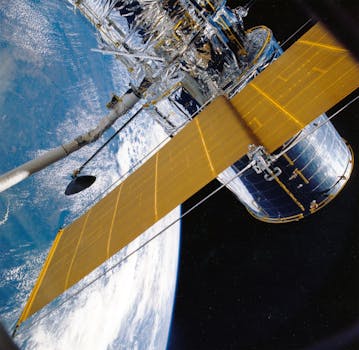From Ground to Sky: The Evolution of Satellite Telecommunications Technology
The evolution of satellite telecommunications technology has revolutionized the way we communicate, enabling global connectivity and transforming industries. This article explores the history and development of satellite telecommunications, from its inception to the latest advancements.

From Ground to Sky: The Evolution of Satellite Telecommunications Technology
Satellite Telecommunications Technology has come a long way since its inception, revolutionizing the way we communicate and transforming industries in the process. The concept of satellite telecommunications was first introduced in the 1940s, but it wasn’t until the 1960s that the first commercial satellite communications systems were launched. Today, satellite telecommunications play a vital role in global communication, providing connectivity to remote and underserved areas, and enabling a wide range of applications, from navigation and weather forecasting to television broadcasting and internet services.
The development of satellite telecommunications technology can be divided into several stages. The first stage involved the launch of the first artificial satellite, Sputnik, in 1957, which marked the beginning of the space age. The successful launch of Sputnik led to the development of the first commercial satellite communications systems, including Intelsat and Comsat, in the 1960s. These early systems used geosynchronous satellites, which remain in a fixed position above the equator, to provide transatlantic communications services.
The Early Years of Satellite Telecommunications
In the early years of satellite telecommunications, the technology was primarily used for voice communications, with the first transatlantic telephone call via satellite taking place in 1962. The 1970s saw the introduction of satellite television broadcasting, with the launch of the first direct broadcast satellite (DBS) in 1976. The 1980s witnessed significant advancements in satellite technology, with the introduction of mobile satellite communications, which enabled communication on-the-move.
The 1990s saw the dawn of the internet age, with satellite telecommunications playing a crucial role in providing global internet connectivity. The launch of the Iridium satellite constellation in 1998 marked a significant milestone in the development of satellite telecommunications, enabling global mobile communications. The early 2000s saw the introduction of broadband satellite internet services, which provided high-speed internet access to remote and underserved areas.
Advances in Satellite Telecommunications Technology
Recent years have seen significant advances in satellite telecommunications technology, with the development of high-throughput satellites (HTS) and the introduction of new constellations, such as OneWeb and Starlink. These advancements have enabled faster and more reliable satellite communications, with greater capacity and lower latency. The use of advanced technologies, such as phased array antennas and digital signal processing, has also improved the efficiency and performance of satellite communications systems.
The development of 5G networks has also driven innovation in satellite telecommunications, with the introduction of new satellite constellations and the use of satellite-based 5G services. The integration of satellite and terrestrial networks has enabled the creation of hybrid networks, which provide seamless connectivity and improved network performance. The use of artificial intelligence (AI) and machine learning (ML) is also being explored in satellite telecommunications, to optimize network performance and improve the quality of service.
Applications of Satellite Telecommunications Technology
Satellite telecommunications technology has a wide range of applications, from navigation and weather forecasting to television broadcasting and internet services. Satellite navigation systems, such as GPS and GLONASS, provide location information and timing signals, which are used in a variety of applications, including aviation, maritime, and land transportation. Satellite-based weather forecasting systems provide critical weather information, which is used to predict weather patterns and issue early warnings for severe weather events.
Satellite television broadcasting provides entertainment and information services to a global audience, with many channels available via satellite. Satellite-based internet services provide connectivity to remote and underserved areas, enabling access to information and communication services. The use of satellite telecommunications technology is also being explored in other areas, such as disaster response and recovery, and environmental monitoring.
In conclusion, the evolution of satellite telecommunications technology has been a remarkable journey, from its inception to the latest advancements. The development of satellite telecommunications has revolutionized the way we communicate, enabling global connectivity and transforming industries. As technology continues to advance, we can expect to see even more innovative applications of satellite telecommunications, enabling a more connected and interconnected world.





